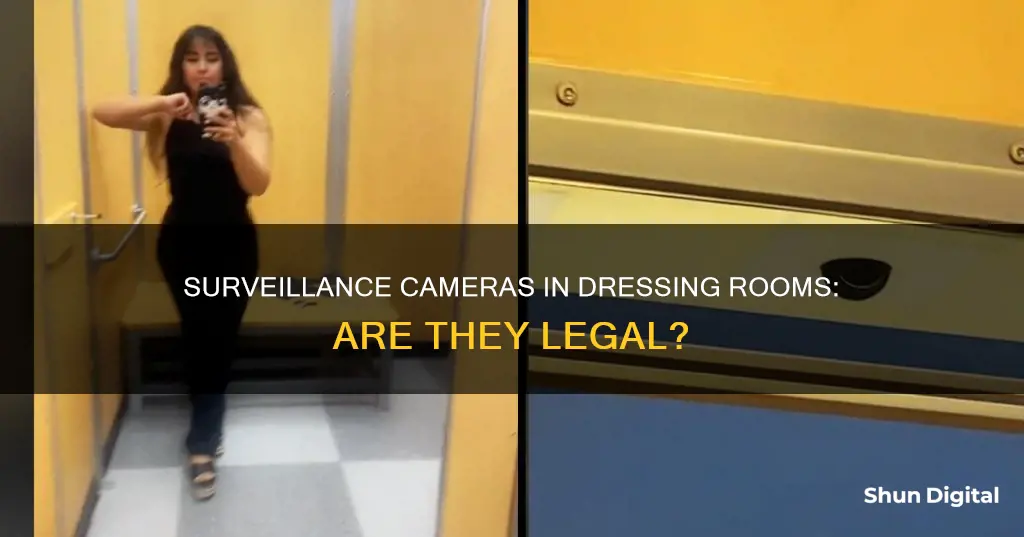
The use of surveillance cameras in dressing rooms is a contentious issue, with privacy concerns sparking legal debates. While some states permit the use of cameras or two-way mirrors for theft prevention, others have banned the practice outright. The legality of surveillance in dressing rooms hinges on state-specific legislation and the purpose of the monitoring. With advancements in technology, retailers are increasingly turning to surveillance as a means to curb shrinkage or inventory loss due to shoplifting and employee theft, sparking concerns about privacy violations.
| Characteristics | Values |
|---|---|
| Legality of surveillance cameras in dressing rooms | Depends on the state |
| Surveillance legality in Alabama, Arkansas, California, Delaware, Georgia, Hawaii, Kansas, Maine, Michigan, Minnesota, New Hampshire, South Dakota, and Utah | Prohibited without the express permission of the shopper |
| Surveillance legality in California | Banned except for the federal government |
| Surveillance legality in Connecticut | Banned in areas designed for employee rest or comfort |
| Surveillance legality in Massachusetts | Contradictory laws, one prohibits monitoring, another allows it if customers are warned |
| Surveillance legality in the remaining 37 states | Informed consent required |
| Legality of surveillance for purposes other than theft prevention | Illegal |
| Legality of surveillance in other private areas | Illegal |
What You'll Learn
- Legality of surveillance cameras in dressing rooms varies by state
- Surveillance cameras in dressing rooms are used to prevent theft
- Surveillance cameras in dressing rooms may violate privacy rights
- Surveillance cameras in dressing rooms may be allowed with informed consent
- Surveillance cameras in dressing rooms may be illegal if used for voyeurism

Legality of surveillance cameras in dressing rooms varies by state
The legality of installing surveillance cameras in dressing rooms depends on the state. In some states, it is perfectly legal to monitor a store's dressing room using a camera or a two-way mirror. In other states, the practice is banned due to privacy concerns.
Thirteen states prohibit dressing room surveillance without the express permission of the shopper: Alabama, Arkansas, California, Delaware, Georgia, Hawaii, Kansas, Maine, Michigan, Minnesota, New Hampshire, South Dakota, and Utah.
The majority of states have taken an "informed consent" approach, allowing changing-room surveillance but requiring stores to post conspicuous signs to inform consumers that they are being monitored. Some states permit only real-time surveillance, while others allow the use of recording devices.
Regardless of the state, video surveillance in sensitive areas such as dressing rooms or restrooms is illegal if conducted for any purpose other than theft prevention. Such conduct could fall under laws prohibiting voyeurism, which is the act of recording unsuspecting individuals who may be naked or disrobing for sexual excitement. It also violates the Video Voyeurism Prevention Act, which specifies the intent to capture an image of an individual's private area without their consent.
The use of surveillance cameras in dressing rooms is a controversial issue, balancing the need for loss prevention in retail stores with individuals' expectations of privacy.
Polaroid Cameras: Still in Production, Still in Demand
You may want to see also

Surveillance cameras in dressing rooms are used to prevent theft
The use of surveillance cameras in dressing rooms is a controversial topic that has raised concerns about privacy rights. While some people argue that it is an invasion of privacy, others justify its use as a means to prevent theft and protect their business.
Retail stores have been using surveillance cameras to monitor dressing rooms, and this practice is becoming more common due to advancements in technology, such as smaller and less expensive cameras. The primary reason for installing cameras in dressing rooms is to prevent theft and reduce inventory loss due to shoplifting or employee theft, commonly known as "shrinkage" in the retail industry. This type of loss has resulted in significant financial losses for retailers, with reports estimating the cost of retail theft at $2 billion to $60 billion annually in North America.
While the legality of surveillance cameras in dressing rooms varies from state to state, it is generally permitted in most states. However, there are specific conditions that must be met. Firstly, the business must have a legitimate need for filming, such as preventing theft. Secondly, the areas under surveillance should be public, and employees or customers must be made aware that they are being filmed. This is often done through informed consent, where individuals are notified through conspicuous signage.
It is important to note that using surveillance cameras in dressing rooms solely for theft prevention is crucial. In all states, video monitoring in sensitive areas, such as dressing rooms, for any other purpose is illegal and may fall under voyeurism laws. These laws protect individuals from invasions of privacy, sexual exploitation, and voyeurism, which is defined as observing unsuspecting individuals who are undressing or naked for sexual excitement.
In summary, while the use of surveillance cameras in dressing rooms is legal in many states, it is a highly sensitive issue. Retailers must carefully navigate privacy rights while employing these security measures to prevent theft and protect their inventory.
Charging Your A6000: A Step-by-Step Guide to Powering Your Camera
You may want to see also

Surveillance cameras in dressing rooms may violate privacy rights
The use of surveillance cameras in dressing rooms is a legal grey area that varies from state to state in the US. While some states permit the use of cameras in dressing rooms, others ban the practice due to privacy concerns. However, it is important to note that the majority of states have adopted an "informed consent" approach, requiring stores to post conspicuous signs informing customers of the potential monitoring.
The legality of surveillance cameras in dressing rooms is a complex issue that implicates privacy rights. While businesses often argue for the need to prevent theft, customers have a reasonable expectation of privacy when using these spaces. This expectation of privacy is supported by federal law, specifically the Video Voyeurism Prevention Act, which prohibits the capturing of images of private areas without an individual's consent.
The act of undressing and trying on clothes in a dressing room is inherently private. Customers expect a level of privacy when they enter these spaces, and the presence of surveillance cameras can violate this expectation. Additionally, the use of cameras in dressing rooms may disproportionately affect women, as anecdotal evidence suggests that women's dressing rooms are monitored more heavily than men's.
The use of surveillance cameras in dressing rooms can also lead to potential abuses. While stores are required to use these cameras solely for loss prevention, there have been instances where employees have misused their access to camera footage for personal gain. Furthermore, the presence of cameras in dressing rooms may create a sense of discomfort and violation among customers, even if the cameras are only used for their stated purpose.
In conclusion, while the use of surveillance cameras in dressing rooms may be legal in some states, it raises significant privacy concerns. Customers have a reasonable expectation of privacy in these spaces, and the use of cameras can violate this expectation. To protect customers' privacy rights, stores should explore alternative methods of loss prevention and ensure that any use of surveillance cameras is properly consented to and strictly monitored.
Focusing Analog Surveillance Cameras: A Step-by-Step Guide
You may want to see also

Surveillance cameras in dressing rooms may be allowed with informed consent
The use of surveillance cameras in dressing rooms is a contentious issue, with privacy concerns and theft prevention at the heart of the debate. While some states have banned the practice, others permit it with certain conditions in place. The legality of surveillance cameras in dressing rooms ultimately depends on the state in which the store is located and whether the surveillance is recorded or a live feed.
In certain states, it is legal to monitor dressing rooms using cameras or two-way mirrors. However, in other states, this practice is prohibited due to privacy concerns. The majority of states have adopted an "informed consent" approach, requiring stores to post conspicuous signs informing customers that they may be monitored. This approach ensures that individuals are aware of the surveillance and can choose to avoid being recorded.
The laws regarding dressing room surveillance vary across states. As of 2018, more than 35 states allowed the presence of security cameras in dressing rooms. However, only 13 states expressly prohibited any form of monitoring system in dressing rooms without the express permission of the shopper. These states include Alabama, Arkansas, California, Delaware, Georgia, Hawaii, Kansas, Maine, Michigan, Minnesota, New Hampshire, South Dakota, and Utah.
It is important to note that, regardless of the state, video surveillance in sensitive areas such as dressing rooms or restrooms is illegal if conducted for any purpose other than theft prevention. Such conduct could be considered voyeurism, which involves recording unsuspecting individuals for sexual excitement. Additionally, it violates the Video Voyeurism Prevention Act, which prohibits capturing images of private areas without an individual's consent.
In conclusion, while the use of surveillance cameras in dressing rooms may be allowed in certain states, obtaining informed consent and ensuring individuals are aware of the monitoring is crucial. The presence of conspicuous signage informing customers of the surveillance is essential to maintaining transparency and respecting individuals' privacy.
Camera Tickets: Valid in Florida?
You may want to see also

Surveillance cameras in dressing rooms may be illegal if used for voyeurism
The legality of surveillance cameras in dressing rooms varies depending on the state. In some states, it is perfectly legal to monitor a store's dressing room using a camera or a two-way mirror. In other states, the practice is banned due to privacy concerns. However, regardless of the state, video surveillance in sensitive areas such as dressing rooms for any purpose other than theft prevention is illegal. This type of conduct may fall under voyeurism laws.
Voyeurism is the act of observing an unsuspecting individual, typically a stranger, who may be naked or disrobing, for the purpose of seeking sexual excitement. The Video Voyeurism Prevention Act, a federal law, protects shoppers from invasion of privacy, sexual exploitation, and voyeurism. It states that anyone who intends to capture an image of an individual's private area without their consent and does so under circumstances where the individual has a reasonable expectation of privacy shall be fined or imprisoned or both.
If you believe that you have been videotaped for a purpose other than theft deterrence, you should consult a personal injury lawyer immediately. Even if the taping was apparent for theft deterrence, a lawyer can help ensure that your rights were not violated. In certain states, the laws governing video surveillance may be unclear, outdated, or may not explicitly permit taping, making any type of video monitoring illegal.
Credit Score Concerns: Camera Tickets' Impact Explained
You may want to see also
Frequently asked questions
It depends on the state. In some states, it is perfectly legal to monitor a store’s dressing room by surveillance camera or two-way mirror. In other states, the practice is banned due to privacy concerns.
As of 2024, only 13 states expressly prohibit the use of any monitoring system in dressing rooms without the express permission of the shopper. These states are Alabama, Arkansas, California, Delaware, Georgia, Hawaii, Kansas, Maine, Michigan, Minnesota, New Hampshire, South Dakota, and Utah.
The majority of states have taken an "informed consent" approach, allowing changing-room surveillance but requiring stores to post conspicuous signs to inform consumers that they are being monitored. Some states permit only real-time surveillance, while others allow the use of recording devices.
If you suspect illegal surveillance in dressing rooms or other private areas, contact a lawyer as soon as possible. Typically, personal injury lawyers are well-equipped for this type of case and can provide counsel on the surveillance laws specific to your region.







